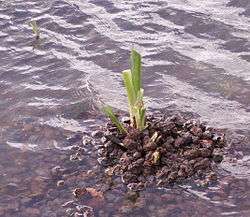Macrophyte

A macrophyte is an aquatic plant that grows in or near water and is either emergent, submergent, or floating, and includes helophytes (a plant that grows in marsh, partly submerged in water, so that it regrows from buds below the water surface).[1] In lakes and rivers macrophytes provide cover for fish and substrate for aquatic invertebrates, produce oxygen, and act as food for some fish and wildlife.[2]
Fringing stands of tall vegetation by water basins and rivers may include helophytes. Examples include stands of Equisetum fluviatile, Glyceria maxima, Hippuris vulgaris, Sagittaria, Carex, Schoenoplectus, Sparganium, Acorus, yellow flag (Iris pseudacorus), Typha and Phragmites australis.
Emergent plants
An emergent plant is one which grows in water but which pierces the surface so that it is partially in air. Collectively, such plants are emergent vegetation.
This habit may have developed because the leaves can photosynthesize more efficiently above the shade of cloudy water and competition from submerged plants but often, the main aerial feature is the flower and the related reproductive process. The emergent habit permits pollination by wind or by flying insects.
There are many species of emergent plants, among them, the reed (Phragmites), Cyperus papyrus, Typha species, flowering rush and wild rice species. These may be found growing in fens but usually less well owing to competition from other plants. Some species, such as purple loosestrife, may grow in water as emergent plants but they are capable of flourishing in fens or simply in damp ground.[3]
As watershed health indicators
A decline in a macrophyte community may indicate water quality problems and changes in the ecological status of the water body. Such problems may be the result of excessive turbidity, herbicides, or salinization. Conversely, overly high nutrient levels may create an overabundance of macrophytes, which may in turn interfere with lake processing.[2]
Macrophyte levels are easy to sample, do not require laboratory analysis, and are easily used for calculating simple abundance metrics.[2]
As potential sources of therapeutic agents
Phytochemical and pharmacological researches suggest that freshwater macrophytes, such as Centella asiatica, Nelumbo nucifera, Nasturtium officinale, Ipomoea aquatica and Ludwigia adscendens, are promising sources of anticancer and antioxidative natural products.[4]
Hot water extracts of the stem and root of Ludwigia adscendens, as well as those of the fruit, leaf and stem of Monochoria hastata were found to have lipoxygenase inhibitory activity. Hot water extract prepared from the leaf of Ludwigia adscendens exhibits alpha-glucosidase inhibitory activity more potent than that of acarbose.[5]
See also
References
- ↑ Hickey, M.; King, C. (2001). The Cambridge Illustrated Glossary of Botanical Terms. Cambridge University Press.
- 1 2 3 "Macrophytes as Indicators of freshwater marshes in Florida" (PDF). Retrieved 2014-04-05.
- ↑ Swearingen, Jil M. (7 July 2009). "PCA Alien Plant Working Group - Purple Loosestrife (Lythrum salicaria)". National Park Service. Retrieved 24 September 2011.
- ↑ Chai TT, Ooh KF, Quah Y, Wong FC (2015) Edible freshwater macrophytes: a source of anticancer and antioxidative natural products—a mini-review. Phytochemistry Reviews 14(3): 443–457
- ↑ Ooh KF, Ong HC, Wong FC, Sit NW, Chai TT (2014) High performance liquid chromatography profiling of health-promoting phytochemicals and evaluation of antioxidant, anti-lipoxygenase, iron chelating and anti-glucosidase activities of wetland macrophytes. Pharmacognosy Magazine 10(39): 443-455.

